These savory sticky pork rice dumplings, known as pork zongzi, are a tasty treat and a perfect signature summer festival food! {Gluten-Free adaptable}
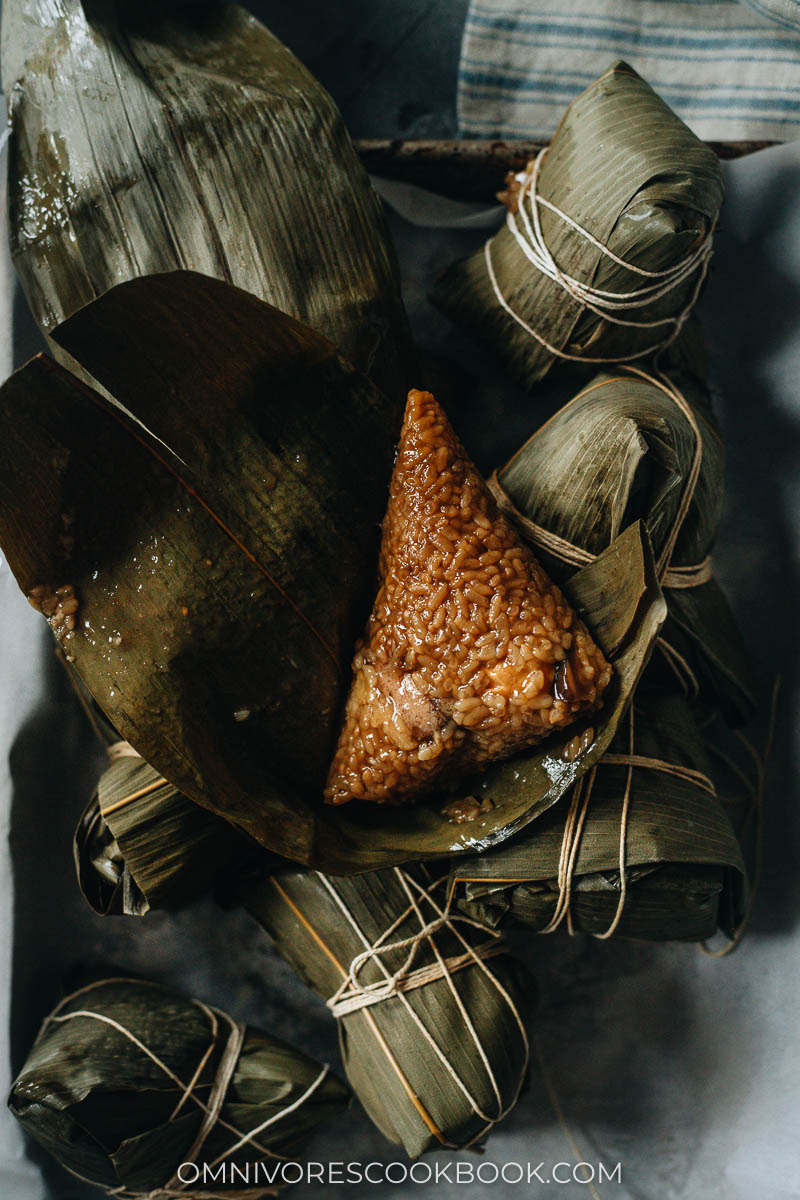
It’s almost time for the famed Dragon Boat Festival in China. Also known as the Duanwu Festival, it has been a tradition for well over 2,000 years. Mostly, the celebration has to do with customs, superstitions, and creating good health. The most traditional custom is the dragon boat race itself, though some people hang Chinese plants as decorations.
And of course, no Dragon Boat Festival would ever be complete without the sticky rice dumplings known as zongzi. I have shared a recipe for zongzi before, but it was a sweet recipe. There are so many kinds of zongzi out there so I thought it would be nice to share a recipe for a pork zongzi that will hit all the savory notes you’re looking for.
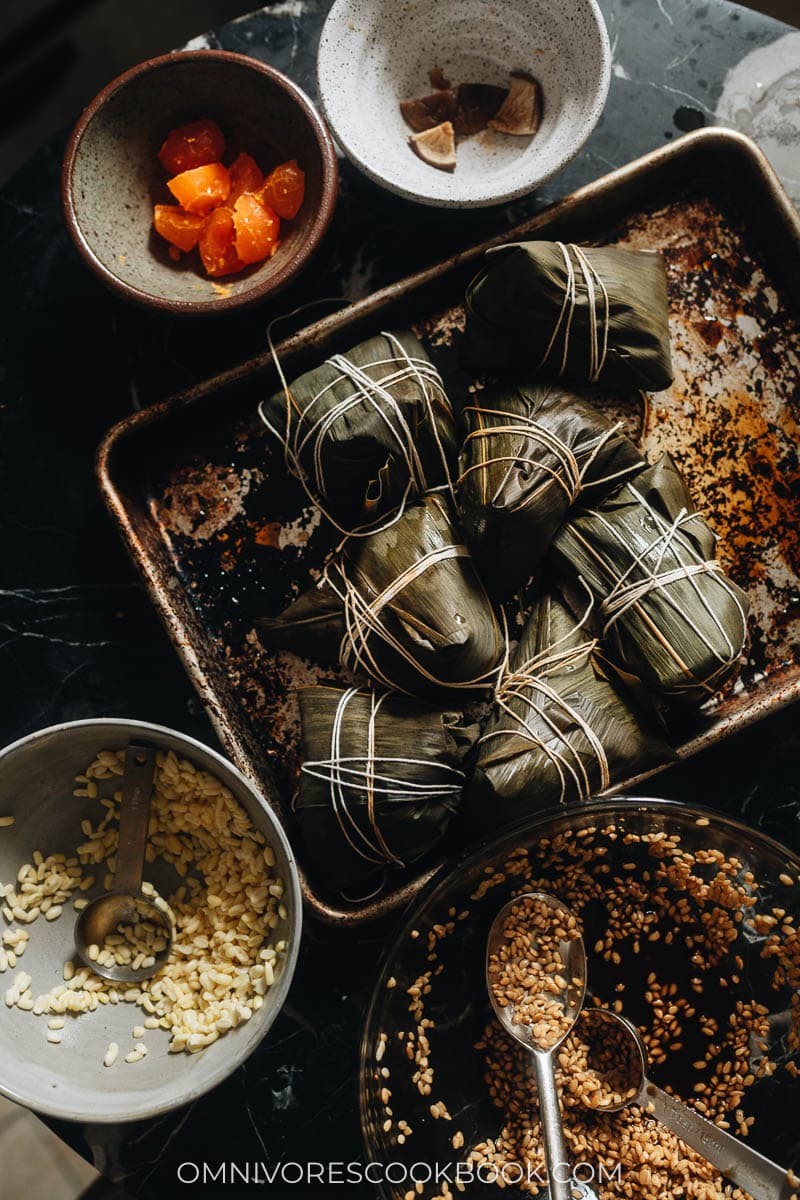
Pork Zongzi
This recipe for pork zongzi has a Cantonese-style filling. It’s savory, rich with pork, and salty, with a combination of duck egg yolk, mung beans, and shiitake mushrooms. I’m not going to lie…Pork zongzi is a time-consuming project that requires a fair amount of prep work but it is absolutely worth it. Many Chinese people will buy zongzi frozen but there is nothing more delicious than fresh-made pork zongzi. Besides, the store-bought ones tend to skimp on the filling which won’t make a good impression if you’ve never tasted zongzi before.
I’ve included a number of notes below so you can replace any ingredients you can’t find, assemble your own pork zongzi with what you have on hand, and fine tune it to your tastes.
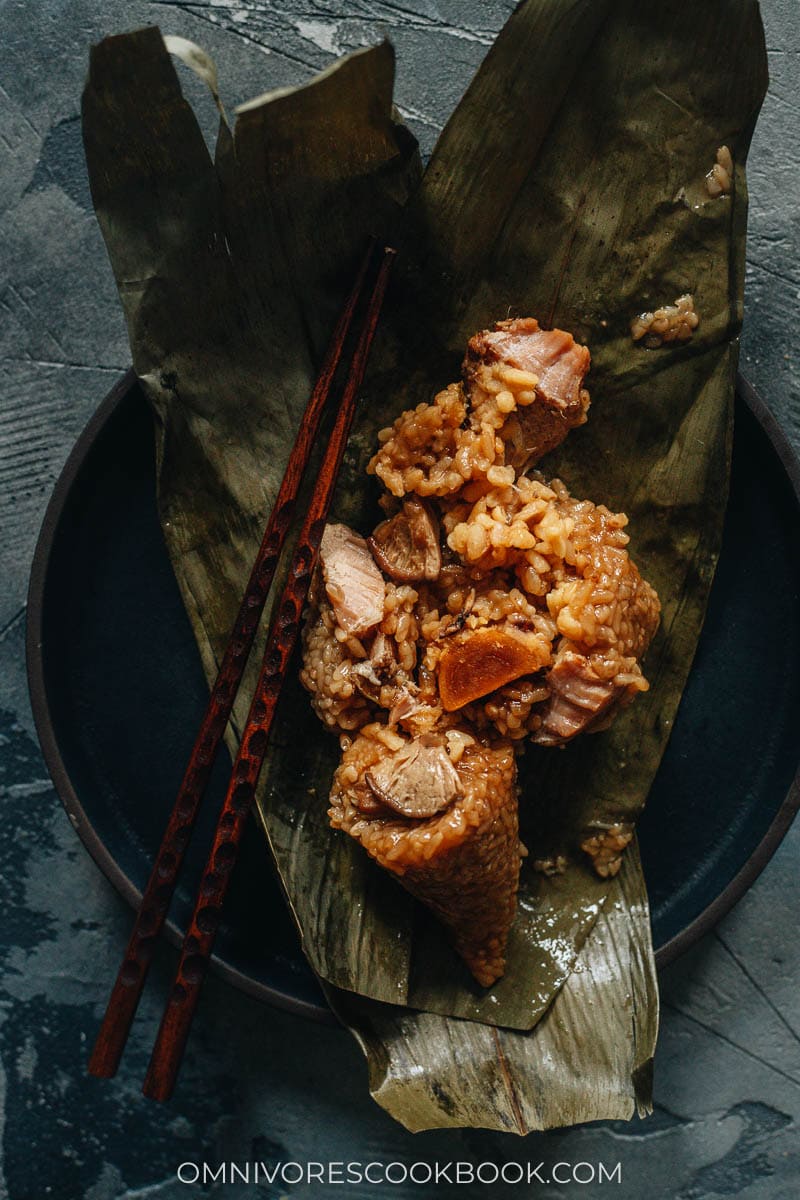
Ingredients
Zongzi leaves
There are several types of Zongzi leaves in China, and the most popular ones are the bamboo leaves. They impart an earthy and refreshing fragrance to the sticky rice and are a very important part of the recipe. When the Dragon Boat festival is close, you can usually find dried bamboo leaves at Asian markets. Sometimes you can also find the fresh bamboo leaves in the refrigerated section. You can even purchase fresh bamboo leaves on Amazon.
If you use the dried leaves, you’ll need to soak them overnight before using them.
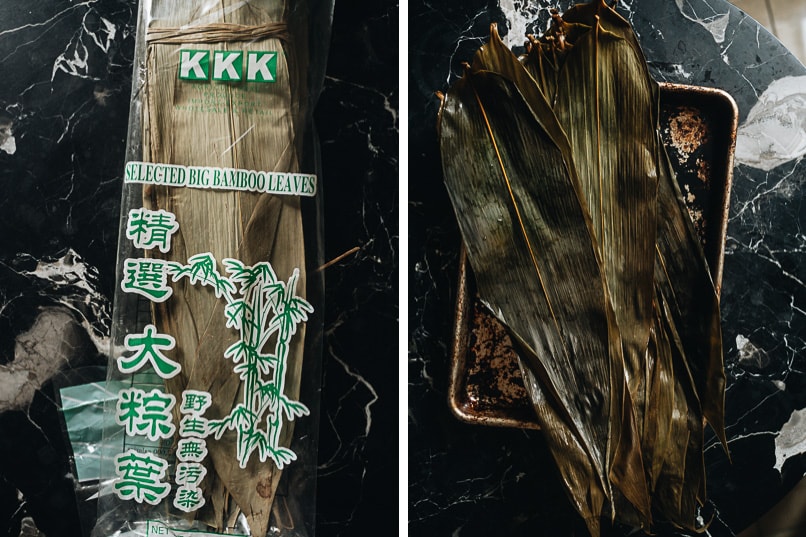
Short grain sweet rice
Sweet rice is also known as glutinous rice or sticky rice (it’s actually gluten-free), and it has a sticky texture once it’s cooked. It’s the ingredient, when made into flour, that gives mochi its bounciness.
It’s important to use short grain sweet rice (NOT long grain) for zongzi, so once you boil the zongzi, the grains are separated and have a better texture. If using long grain sweet rice, the rice will lump together and form a uniform mass.
Unfortunately, sometimes you cannot tell the difference between short and long grain sweet rice by looking at the package. I’ve included two pictures below, so you can find the correct type by looking at the shape of the rice. You can also try to find mochi rice, which is usually the short grain type. You can find it on Amazon as well.
You’ll need to soak the sweet rice overnight before using it.
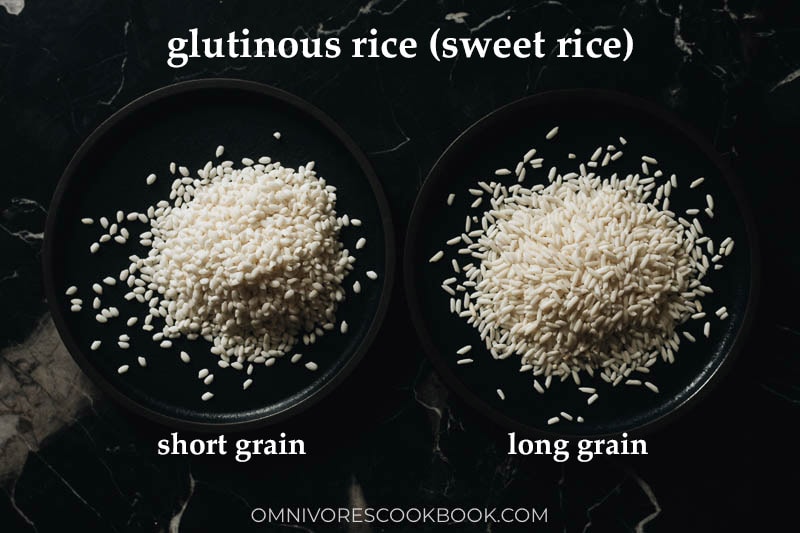
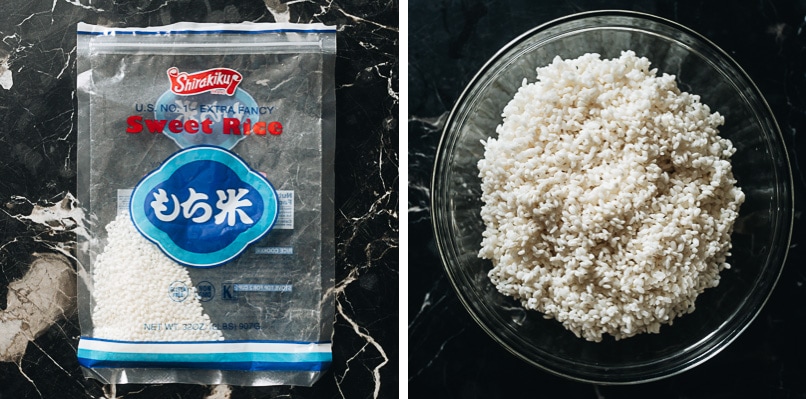
What type of pork to use
Authentic pork zongzi always use fatty pork belly. Sometimes I find it too fatty for my tastes, but you do need pork with a certain amount of fat to make the recipe work. Once the cooking is done, the fat will melt into the rice and create a very delicious result, like when you use lard to make French fries. If you have access to an Asian market, I highly recommend finding a lean chunk of pork belly that has thick strips of pork in between the fat layers. However, if you prefer the dish to be less greasy, you can use pork chops or pork loin with a good amount of fat attached. In this case, it’s important to cut the pork carefully so each chunk has some fat attached.
You will need to marinate the pork in the sauce overnight so it fully absorbs the flavor.
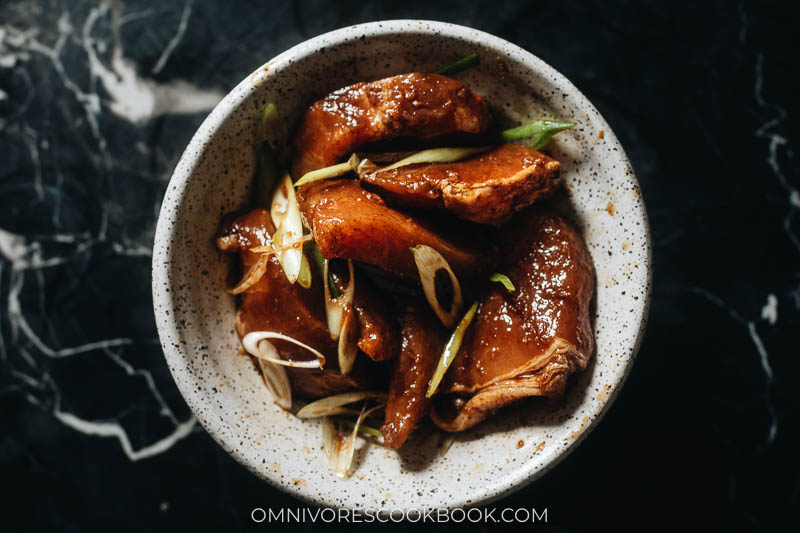
Shelled mung beans
We added some shelled mung beans to the zongzi to add a fun texture. It’s important to use shelled beans, otherwise the shell will create a tough mouthfeel once cooked.
You can find them at Asian grocery stores or use yellow mung dal from Indian grocery stores. You can also purchase them from Amazon.
You will need to soak the mung beans overnight before using.
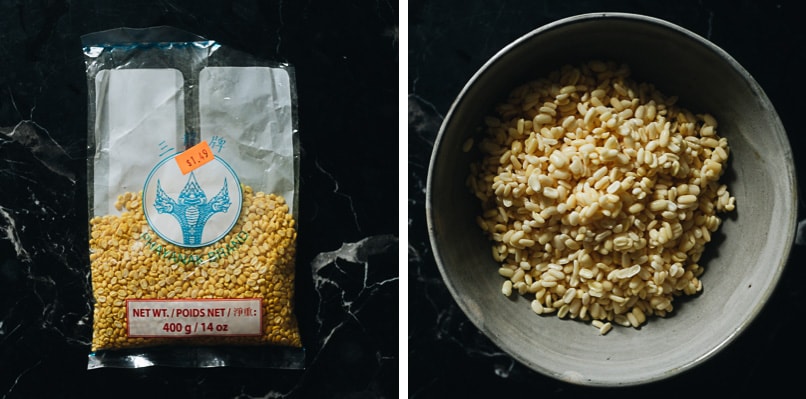
Shiitake mushrooms
Shiitake mushrooms add a delicious smoky and earthy flavor to the rice. I highly recommend using them in your zongzi. I wouldn’t recommend using fresh mushrooms because they tend to shrink a lot and might make your zongzi collapse if you add too much. You can find them at most Asian grocery stores or on Amazon.
Salted duck egg yolks
Another ingredient to add texture and salty umami to your zongzi. Salted duck egg yolk is a common ingredient for making mooncakes and zongzi. For a better texture and more perfect results, buy whole cured duck eggs at Chinese markets and use the yolks. For the sake of convenience, you can purchase the vacuum-packed salty duck egg yolks as well (the texture is a bit gelatinous). You can find both on Amazon (yolk & whole eggs).
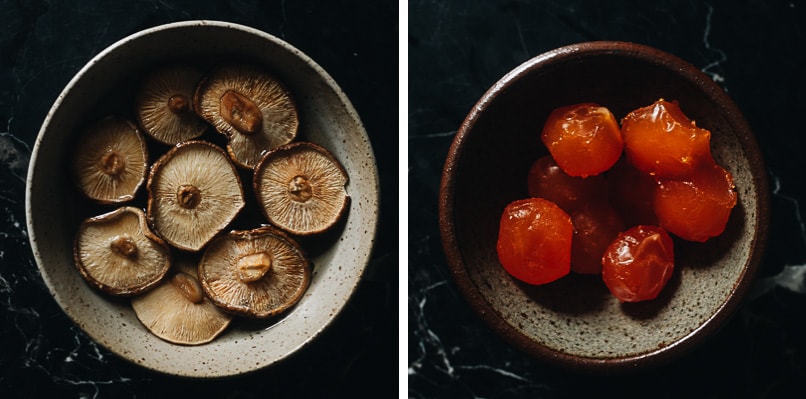
How to replace the ingredients
Pork belly and shiitake mushrooms are the key ingredients.
- You can skip the mung beans and the duck egg yolks if you don’t like them or cannot find them. You can replace both by soaking more sweet rice.
- If you can find roasted and peeled chestnuts, they’re a great ingredient to add to your zongzi to replace the beans and/or the duck eggs.
- Alternatively, you can double up on the pork belly and make the zongzi meatier. Just remember that you’ll need to double up on the marinade as well. (This is my mom’s favorite method to make the zongzi more flavorful)
- You can add some chopped Chinese sausage to the zongzi as well. The sausage is quite sweet, but it works nicely with the savory seasonings in this recipe.
Workflow
It takes some organization to prepare all the ingredients for zongzi. You should marinate the pork and soak the bamboo leaves, sweet rice, and mung beans the day before making the zongzi.
The day you plan to make them, you will need to mix the sauce with the soaked rice, rehydrate the mushrooms, and cut the salty egg yolks. Your table should look at this before wrapping the zongzi.
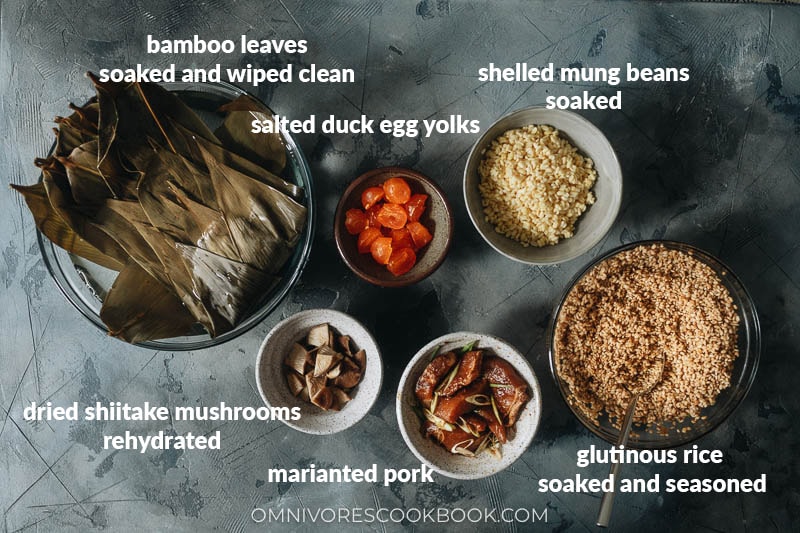
Cooking Process
Prepare the zongzi leaves
- Select two leaves and cut off both ends of each.
- Overlap about half, up to two thirds, of the leaves together.
- Use both of your hands to shape the leaves into a cone.
- Make sure the tails of the leaves are long enough to cover the top of the cone. If not, rearrange the leaves so they overlap less.
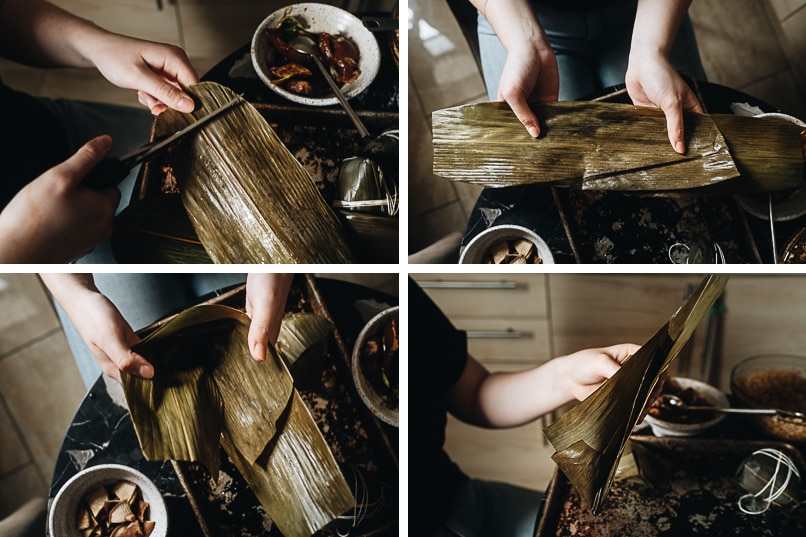
Stuff the filling
- Stuff the bottom of the cone with sweet rice
- Add the pork, egg yolk, and mushrooms
- Place a thin layer of mung beans on top
- Further add sweet rice to almost fill the cone
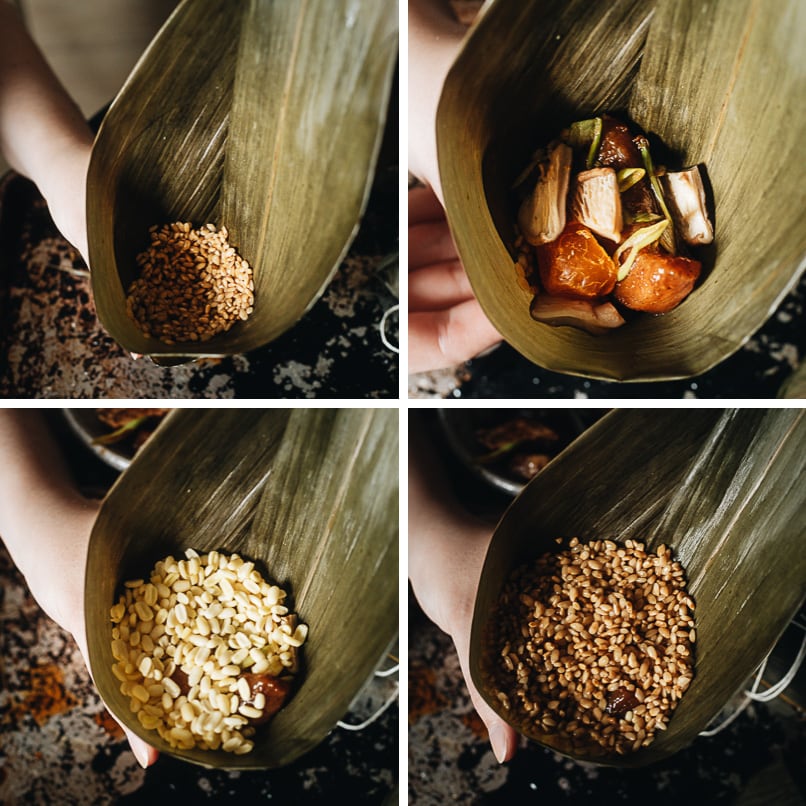
NOTE:
- It’s important to NOT pack the rice with too much force. The rice will expand a lot once cooked and it will make the filling more chewy if you do so.
- If you decide to use two pieces of pork, make sure to space them out and have some rice in between them.
Wrap the zongzi
- Once you’ve filled up the zongzi, carefully fold up the top of the cone to cover the rice
- Fold the tail of the leaves to cover the top of the cone
- Further fold the tail around the cone
- The zongzi will form a triangle shape with all the rice well covered by the bamboo leaves
- Use the prepared kitchen twine to tie up the leaves. You might need to use two pieces of twine to tie the zongzi like a cross so it won’t fall apart during cooking.
- Place the wrapped zongzi on a tray so it catches any marinade liquid that seeps out from the leaves.
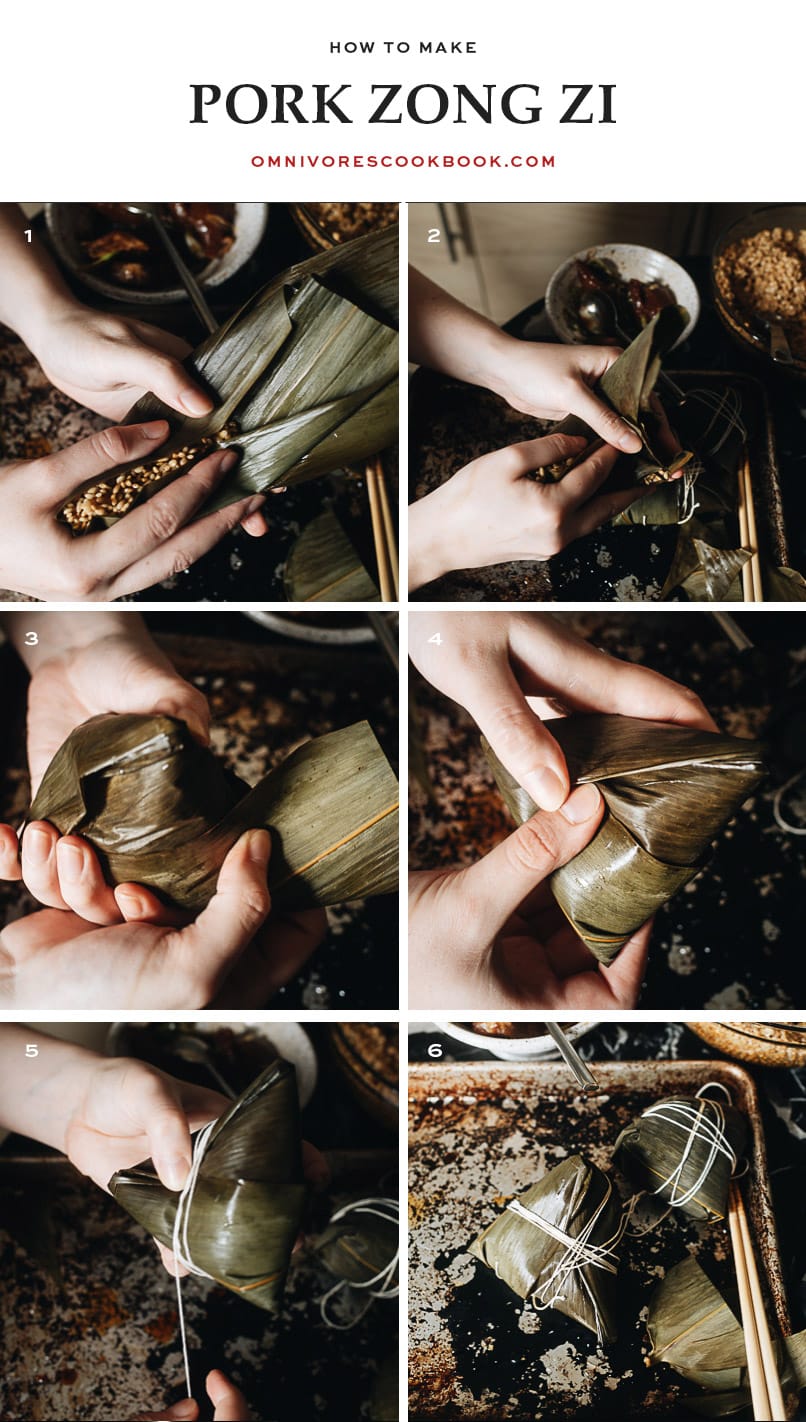
Cook the zongzi
You can either cook zongzi on the stovetop or in an Instant Pot (pressure cooker).
- To cook them on the stove top: cover the zongzi with a lot of water and boil covered for 3 hours.
- To cook in a pressure cooker: cover the zongzi with water and cook at high pressure for 1 hour, then let the pressure release naturally.
Even for the pressure cooker method, you will need about 2 hours if you include the time needed to increase and release the pressure. But I found it slightly easier because you don’t need to monitor the process. I didn’t find a significant difference in the outcomes of the two methods.
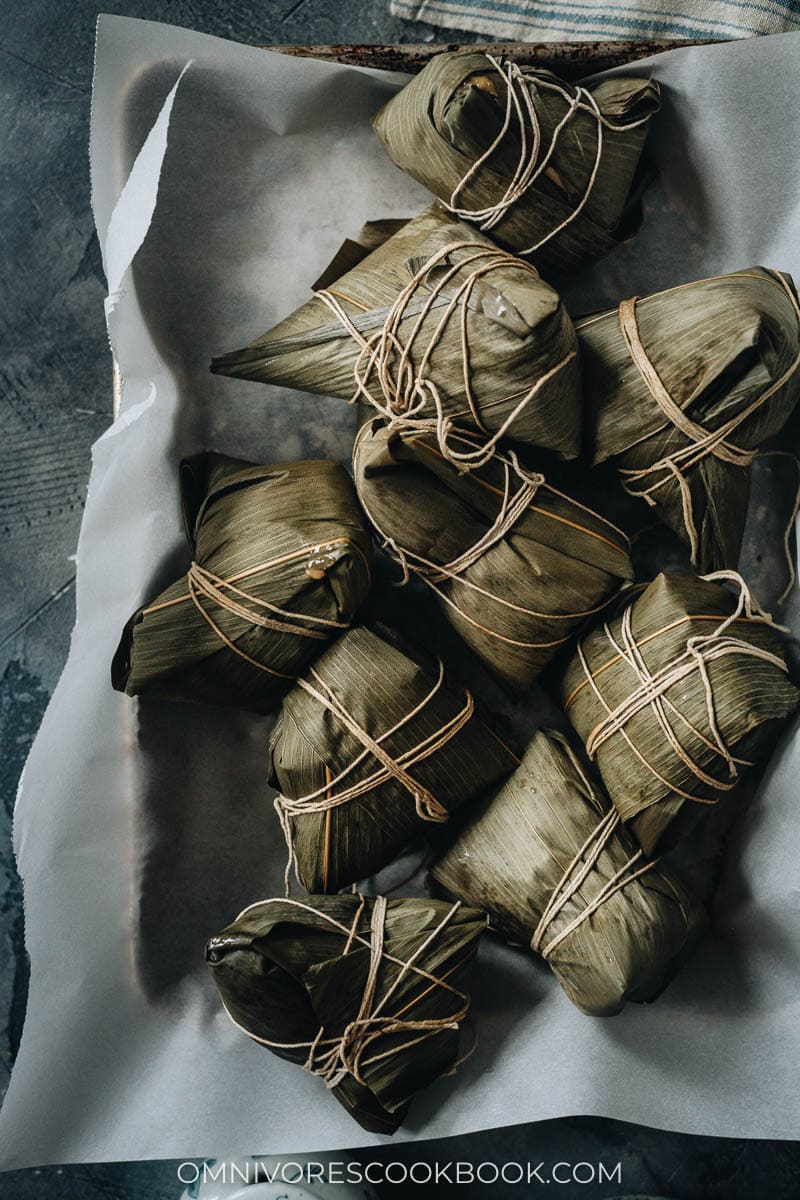
Afterthought
Making pork zongzi is definitely a project you’ll want to set aside half a day to work on. It might seem complicated, but it’s actually a lot of fun to wrap them. And it’s definitely very rewarding one you taste the zongzi. While it does take a while to make, your pork zongzi can be frozen and they’ll be good for 6 months, making them a wonderful edible gift you can give to friends to celebrate the Dragon Boat festival.

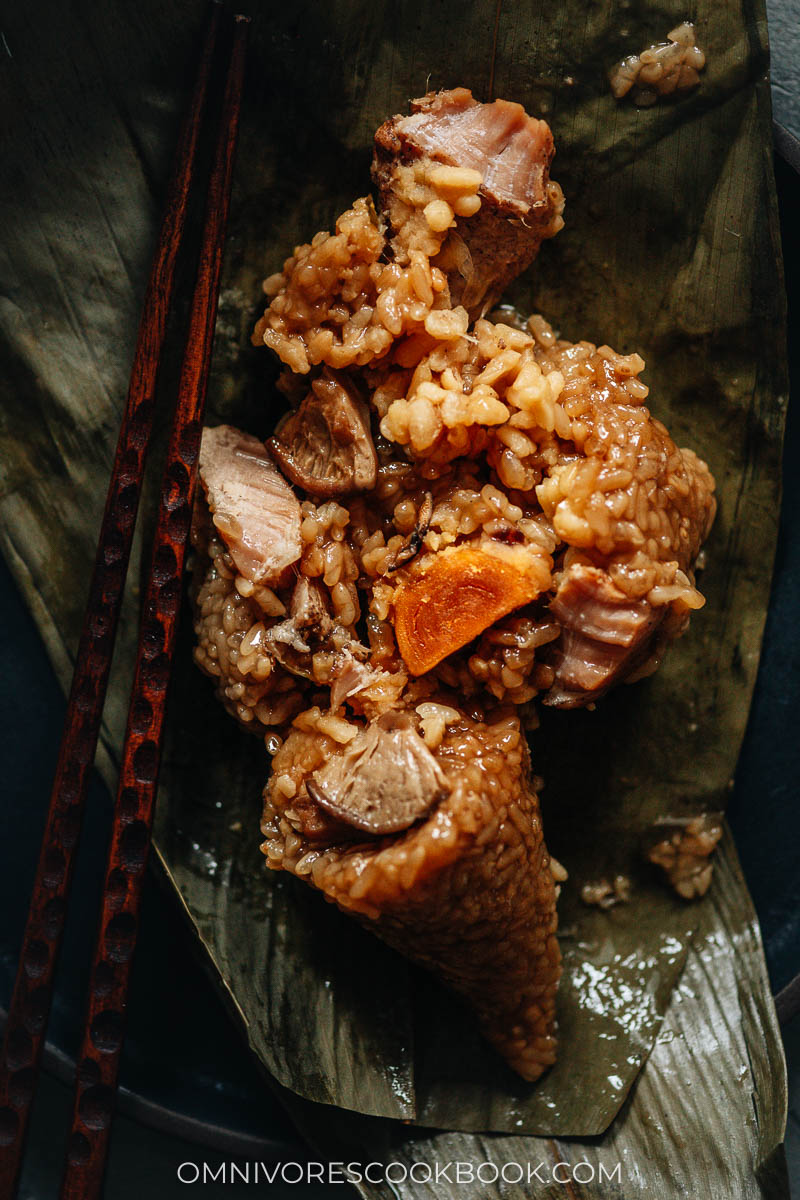
Other pastry to make for Dragon Boat Festival
- Sweet Zongzi with Red Bean Paste
- Sticky Rice Cake with Red Bean Paste
- Sesame Checkerboard Cookies
- Chinese Turnip Cake (Lo Bak Go, 萝卜糕)
Want to learn more about Chinese Cooking? Sign up my newsletter to receive the 5-Day Chinese Cooking Crash Course and recipe update!
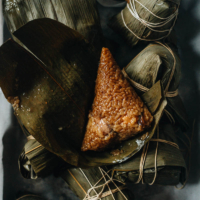
Pork Zongzi (Cantonese Savory Sticky Rice Dumplings)
Ingredients
- 24 to 36 dried bamboo leaves (Footnote 1)
- 24 2 ft (60 cm) twine
Rice
- 3 cups (600 g) short grain sweet rice , washed (Footnote 2)
- 1 teaspoon sugar
- 1 tablespoon soy sauce
- 1 tablespoon dark soy sauce
- 1 tablespoon oyster sauce
Pork
- 12 oz (350 g) fatty pork (pork belly, chop, or loin with fat attached) , cut into 2” (5cm) chunks (Footnote 3)
- 1 tablespoon Shaoxing wine (or dry sherry)
- 2 teaspoons soy sauce
- 1 teaspoon dark soy sauce
- 2 teaspoons sugar
- 1 teaspoon salt
- 1/2 teaspoon five spice powder
- 2 teaspoons grated ginger
- 2 green onions , sliced diagonally
Filling
- 3/4 cup (150 g) shelled mung beans , washed
- 12 dried shiitake mushrooms
- 6 salted duck egg yolks , halved
Instructions
Prepare ahead
- Soak the bamboo leaves, sweet rice, and mung beans separately in water overnight.
- Combine all the pork ingredients and allow to marinate overnight.
The day of making the zongzi
- (Optional- to sanitize the bamboo leaves, remove them from the soaking liquid and add them to a pot with fresh water. Bring it to a boil and cook the leaves for 5 minutes.) Drain the leaves and wipe them each down on both sides. Cut off an inch from the base and an inch from the tip.
- Place the shiitake mushrooms in a medium-sized bowl and add hot water to cover. Soak for 15 to 20 minutes, or until the mushrooms are soft throughout. Drain the mushrooms, squeeze out the excess water, and slice them into quarters.
- Drain the rice and transfer it to a big bowl. Add the seasonings to the rice and mix until evenly coated.
- Drain the mung beans and transfer them to a medium-sized bowl.
- To wrap the zongzi (see the process photos above for the steps)
- Take two leaves, making sure they do not have any holes or tears. Use a pair of kitchen scissors to cut off 1” (2.5 cm) from both ends. Face the smooth sides towards yourself (this is the side that will contain the filling), with the wider base sides facing away from each other, then overlap the leaves to make 1 long strip. There should be 3-4” (8-10 cm) of individual leaf sticking out beyond the overlap on each side. A third of the way along the strip, pinch the side opposite from you and fold it into a cone shape, with the leaf sticking out from one end. Hold the cone using one hand and begin to add the filling with your other hand.
- Add 2-3 tablespoons of rice to the bottom and press it up against the sides to create a small well. Add a piece of pork (make sure every piece added has a chunk of fat), half a yolk, two quarters a shiitake, and 1 to 2 tablespoons of mung beans. Add 2 to 3 tablespoons of rice over everything. Gently press and smooth as you do. There should be a 1/4” (1/2 cm) lip around the rice.
- Take the open side of the zongzi between your thumb and index finger and fold the sides inwards, covering the rice. Fold the long leaves over the open area, tightening between your thumb and index finger to create a pointed triangular shape. Then flip the zongzi over and wrap the leaves around tightly to seal it. Wrap the zongzi in a piece of twine, making sure it is cinching any area where the leaf might come loose, and tie it off. For extra security, you can use another piece of twine to wrap the zongzi again, crosswise.
Cook the zongzi
- Cook on the stovetop: Bring a large pot of water to boil and add the zongzi. Return the pot to a low simmer and cook covered for 3 hours (4 if the zongzi are very large).
- Cook in an Instant Pot: Add the zongzi to an Instant Pot and water to cover. Close the lid and make sure the valve is sealed. Choose “Manual” at “High Pressure” and set a timer for 1 hour. Once done, let the Instant Pot release the pressure naturally.
- Drain the zongzi from the water and serve hot.
Store and reheat
- Store cooked and wrapped zongzi in an airtight container or Ziplock bag in the fridge for 5 days or in the freezer for up to 6 months. To reheat, thaw the zongzi completely in the fridge overnight. Boil the zongzi in water until heated through, 15 to 20 minutes. You can heat up the unwrapped zongzi in a microwave as well.
Notes
- You will use fewer leaves in reality, but it’s always good to soak a few extras so you have enough later in case some of the leaves rip apart.
- It’s very important to use short grain sweet rice. See the blog post above to understand the difference.
- Traditional zongzi always use pork belly. The fat will eventually melt into the rice to create a delicious taste. If you wish to use a leaner cut of pork, loin or pork chop with a big chunk of fat attached is a good option too.
Nutrition
If you give this recipe a try, let us know! Leave a comment, rate it (once you’ve tried it), and take a picture and tag it @omnivorescookbook on Instagram! I’d love to see what you come up with.
Other dishes to make for Dragon Boat Festival
- Sweet and Sour Fish
- Red Bean Soup
- Chinese Tea Eggs (w/ Soft and Hard Boiled Eggs, 茶叶蛋)
- The Best Chinese Noodle Sauce (Da Lu Mian, 打卤面)
- Eight Treasure Rice (八宝饭, Chinese Rice Pudding)
Lilja Walter is a part of the Omnivore’s Cookbook team and worked closely with Maggie to develop and test this recipe.













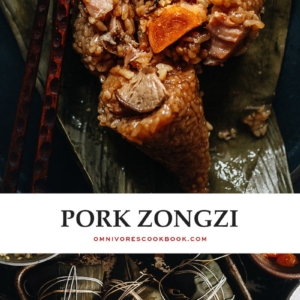
Oh wow I can’t wait to make these at home! We first tried them from a street seller in Taiwan during Chinese New Year – at the time we had no idea what they were or what was in store, but the flavour is one we’ll never forget. Thanks for the recipe and such detailed instructions, I feel ready to tackle them now! 🙂
I have giant bamboo growing in my back yard. Can I use the leaves from this bamboo? Since they would be fresh, what would I need to do besides cleaning it?
Thanks.
If they’re big enough you can definitely use them. Since you’re using the fresh leaves you won’t need to soak them in the water before wrapping.
I’m drawn to your recipe due to the dark color of the cooked rice–when I’ve made it in the past, the rice loses color when boiling. Do you have any insight on how your rice stays such a nice color in the finished zongzi?
The dark color mostly came from dark soy sauce. If you use regular soy sauce, the rice won’t be as dark. Did you use dark soy sauce in your previous zongzi?
I think as long as you wrapped them alright and they don’t fall apart during cooking, it usually shouldn’t lose that much color.
I do prefer to cook zongzi in a pressure cooker. It uses less time and I do think it keeps the zongzi more intact.
Mom and Grandma used to make these; I loved them. We usually added chestnuts and peanuts to ours. And some lily buds. One time someone gave us some ham which was very salty and a discussion followed as to what to do with it. Dumplings and congee were the answers.
(golden needles) too.